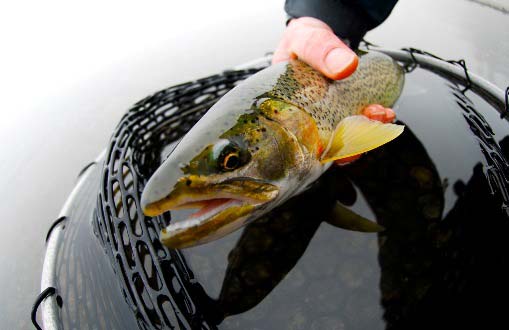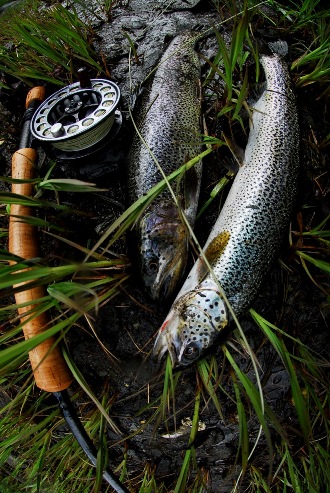
The first true trout documented in the United States were cutthroat. They were caught by Silas Goodrich on June 13, 1805, and recorded for posterity in the journal of Captain Meriwether Lewis, who after noting the size, color and markings of the strange species, seemed to particularly enjoy the variety they added to the daily menu.
These were westslope cutthroat trout, Oncorhynchus clarki lewisi, caught on the east side of the continental divide. It’s an interesting sidebar to the Voyage of Discovery, which did so much to alert Americans to the natural treasures that existed in the West, as since then the signature trout of the Rockies have found the going tough in all but a few of their natal watersheds. In fact, according to the Montana Department of Fish, Wildlife and Parks, the westslope cutthroat is currently found in only 30 to 40 percent of its historical range. The fish are especially threatened east of the divide in Montana, where those numbers plummet to around five percent. In myriad drainages, pure strains are assumed to have been lost forever. 
The story is much the same for other subspecies of cutthroat (most fisheries scientists recognize 14), all of which are particularly susceptible to predation, hybridization, and the environmental impacts associated with the spread of civilization. Two are extinct and a few more—like greenbacks and the Lahontan cutthroat—are on the endangered list. Others still have been proposed for listing. However, not too many years ago, a population of pure-strain cutthroat was discovered in a small creek that tumbles from Montana’s Pryor Mountains. Their discovery was cause for much joy from anglers and biologists alike, as these were Yellowstone cutthroat, Oncorhynchus clarki bouvieri, which are also richly linked to historical images of the state’s fisheries, not least because of an appearance they made in another journal, this one kept by Captain John Bourke, noted Indian fighter and adjutant to General George Crook during the summer campaign of 1876.
In June of that year, as the men under Crook’s command were bivouacked in Bighorn country and finding ennui the order of the day, Bourke and a few others began fishing in the upstream tributaries of the Tongue River system. The cavalrymen binged on the action, soon feeding the entire camp with the proceeds of their angling success. After a move to the northwest and the resulting run-in with Crazy Horse at Rosebud Creek, which didn’t go so well for the soldiers, Crook, Bourke and the rest of the men returned to the site of their former camp on Goose Creek, and to their fishing. The action was apparently so steady that Crook had to issue an edict limiting their catch. According to the journals, the general then went out and promptly had himself a 50-fish day.
To me, these stories of the cutthroat, both the highs and the lows, are particularly resonant in Alaska, as ironically, anglers in search of the only trout species native to the widely-heralded waters of the Rocky Mountain West would be better advised to pack their bags for the Lost Coast instead of Colorado, for Turner or Wilson and not Pyramid Lake, for Petersburg rather than Ennis. In many blue-ribbon waters of the West, the cutthroat have been elbowed out, inadvertently replaced by rainbows and browns, over-fished, polluted and logged and dammed to death. But in the small lakes and tumbling creeks that dot and cross the heavily forested southeastern coast of Alaska, the small, speckled trout of the Rockies yet thrives.
All of Alaska’s cutthroat are of the coastal subspecies, Oncorhynchus clarki clarki, and they exist along the coast from Dixon Entrance at the southern tip of the state north to Prince William Sound and Gore Point on the southern side of the Kenai Peninsula. Within that range, anglers would be hard pressed to find an area without a healthy population nearby, whether on Prince of Wales Island or within the environs surrounding Haines, in Turner and Jims lakes near Juneau or in Lake Eva on Baranof Island, or among the innumerable straits, bays, lakes, and small creeks of the Petersburg and Wrangell region. There are likewise excellent stocks to be found on the mainland east of Ketchikan, in and around Misty Fjords National Monument, which is probably home to the highest concentration of directed angling for the species in the state. The North Gulf (or Lost) Coast is thought to be a paradise of undiscovered cutthroat trout fishing, with a few streams already well-known for their production. And near the northernmost limits of the coastal cutthroat’s native range there are a number of viable options, including streams in the vicinity of Cordova as well as other, more remote coastal areas in Prince William Sound. This includes the creeks crisscrossing the region’s larger islands, notably Montague and Green.
This potential—the sheer geographical breadth of the opportunity, as well as the vitality of these untouched populations—makes for easy parallels with the American West encountered by early pioneers or the soldiers of North Plains Campaign. That those Rocky Mountain cutthroat find themselves in trouble these days should serve as a call for caution, as a reminder that even generals aren’t guaranteed 50-fish days.
So, next summer, when the waters of the Southcentral road system are packed with anglers after kings and sockeye, why not try something a little different, pursue some adventure, explore? Who knows: you might stumble upon a small lake with rises dimpling the surface. No one else will be there. Just you and the signature trout of the West.
